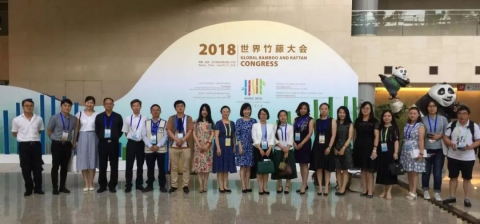
GCED Basic Search Form
Quick Search
You are here
News

On 26th June, the UNESCO & INBAR (International Network for Bamboo and Rattan) joint session at the Global Bamboo and Rattan Congress “Linking Bamboo and World Heritage with Creativity” draw to a successful close at the National Convention Centre in Beijing. 28 representatives from 22 organizations participated in the session, including the Ministry of Culture and Tourism, the pilot World Heritage sites of Shilin (South China Karst), Chishui (China Danxia), and Ya’an (Sichuan Giant Panda Sanctuaries), Chengbu Miao Autonomous County of Shaoyang Municipality of Hunan Province, Beijing Gugong Cultural Promotion Co., Ltd, Jingdezhen Ceramic Culture Tourism Group, Shanghai Academy of Fine Arts, Tsingyuan Culture Heritage and China Youth Development Foundation Mercedes-Benz Star Fund.
The session consisted of 2 parts, in the first session of “setting the scene”, Ms. Li Yanxia, the Senior Officer of Global Programme of INBAR, Ms. Zhang Xiaoli, the Consultant of Management Section, Intangible Cultural Heritage Department of the Ministry of Culture and Tourism, and Ms. Lu Ye, Project Officer for Culture at UNESCO Beijing Office gave interpretations on the concepts of “Bamboo and Rattan”, “Intangible Cultural Heritage” and “World Heritage Sustainable Livelihood” respectively, which are the guiding concepts of the whole session. From the adaptation of bamboo and rattan industry to the social-economic development, Ms. Li Yanxia introduced the role of bamboo and rattan industry in promoting the United Nations 2030 Agenda for Sustainable Development Goals. Ms. Zhang Xiaoli introduced the efforts made and achievements obtained in intangible cultural heritage safeguarding in recent years in China, and the initiatives and practices in addressing the challenges within the context of industrialization and urbanization. Ms. Lu Ye mainly introduced the concept of the World Heritage Sustainable Livelihood activity under the UNESCO-China Youth Development Foundation Mercedes-Benz Star Fund Cooperation Project, and the contribution and potentials through combining the power of heritage sites, traditional practice and creative industries to promote heritage and sustainable socio-economic developments.
In the round-table discussion session, the representatives presented the works of their respective fields, their challenges faced and cooperation needed, the relationships between intangible cultural heritage, cultural creativity, World Heritage and sustainable development were discussed, and directional recommendations were made towards multi-stakeholder cooperation in the future. Mr. Fang Kai, the Standing Committee Member of County CPC Committee, Deputy County Chief of Chengbu Miao Autonomous County of Shaoyang Municipality of Hunan Province presented the poverty alleviation concept of “ecological development” and the development status of the local bamboo industry, expressing the will to promoting the poverty alleviation of Chengbu through expanding cooperation. Subsequently, Mr. Liao Chaolin, the Deputy Director of Chishui Scenic and Historic Area Management Bureau and Ms. Yang Changqin, ICH transmitter, Mr. Ang Gui from Shilin Scenic and Hitoric Area Management Bureau and Ms. Chen Nan, the Trustee of Human and Environment Linkage Programme introduced respectively the implementing status of the UNESCO World Heritage Sustainable Livelihood activity, including the preliminary accomplishments and future plans.
From the aspect of the role of universities in promoting intangible cultural heritage continuation and training transmitters, Prof. Jin Jiangbo from Shanghai Academy of Fine Arts introduced the activities implemented by his university, such as training ICH transmitters through ICH training classes and teaching cooperation on national and international levels, as well as innovative activities introducing ICH and creativity to primary schools and communities. Mr. Liu Zili, the President of Jindezhen Ceramic Culture Tourism Group then gave a talk on how Jindezhen, based on the transmission of porcelain craftsmanship, has established a hybrid cultural and creative industrial park to revive traditional porcelain craftsmanship among young generation. Ms. Chen Yuanyuan, the Vice CEO of Beijing Gugong Cultural Promotion Co., Ltd, talked about the concept of approaches of the Palace Museum exploiting creative products based on its collections, with examples of the products produced. At last, on behalf of the Star Fund, Ms. Zhang Xiaoju, the Senior Manager of Media Relations and Corporate Social Responsibility, introduced the aspiration of Mercedes-Benz in promoting World Heritage conservation, and its main focuses in social responsibilities, expressing the hope of promoting World Heritage Sustainable Livelihood, by enhancing the long term cooperation with the UNESCO and making use of the commercial resources and platform of Mercedes-Benz.
This session enabled a dialogue between multiple parties, it is not only important to enhancing the horizontal connections between World Heritage sites, but also providing a platform to expand the cooperation between the cultural and creative industries and private enterprises. Just as Ms. Azoulay, the Director-General of UNESCO, pointed at the opening ceremony of the 42nd session of the World Heritage Committee, “…proud of the diversity and richness of World Heritage. Heritage conservation is an approach of cooperation, is a partnership”. As the follow-up of the session, the activity shall further study and enact an action plan to facilitate the establishment of multi-stakeholder partnerships, and provide more good practices to World Heritage conservation and sustainable development.
URL:
